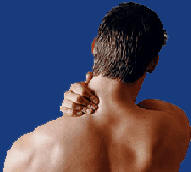Neck Pain Rehabilitation

| The Physical Medicine and Rehabilitation Physician ... Adding Quality to Life |
|
Neck Pain Rehabilitation |
|
|
| Advanced Medical Rehabilitation Group | ||||
| Gary DiBlasio, M.D., P.A. | ||||
| 701 Northlake Boulevard North Palm Beach, FL 33408 ● Suite 208 | ||||
|
1807 South Kanner Hwy, Stuart, FL 34994 |
||||
|
Voice: (561) 863-2828 ● Fax: (561) 863-2914 |
||||
|
Dedicated to the state-of-the-art non-invasive medical treatment of spine and pain disorders. |
||||
|
|
||||
Developing a Program Thatís Right for You: Information is readily available on the way to stop neck pain. The challenge is to tailor it to the particular patient. For example, itís said that using certain kinds of pillows are best for the neck. But which kind? And does the information apply to every kind of neck pain? Using the telephone improperly is also said to create problems in the neck. But what is the proper way to use a phone? And if a brace or special piece of equipment is necessary, which is the right one? The list goes on: cold or hot applications rest or activity? What Kinds of Problems Might Cause Neck Pain? Treatment for any neck condition is recommended as soon as possible to minimize the danger of further aggravation. The following is a list of only some of the conditions that may cause neck pain and is not a substitute for a visit to your doctor: Radiculopathy A pinched nerve, often from a herniated, or slipped, disk. This causes pain down the arm thatís often described as an electrical feeling. Myofascial Pain: Generally an aching pain in muscles that to be associated with poor posture, sitting at a computer or other job-related tasks. Patients can become sore in different parts of the body like the neck and arms, and often patients report they have difficulty sleeping or feeling restored from sleep. Spinal Stenosis: A narrowing of the nerve openings either around the spinal cord or nerve roots that can cause symptoms similar to a pinched nerve. The pain is described either as an aching or an electrical feeling down the arm. Tendon, Ligament and Soft Tissue Pain: Localized pain when an area is stretched or its muscles are overused. This results in tenderness. Spinal Instability: Increased motion vertebra usually resulting from an injury. The pain typically feels like tingling in the neck or arms. Non-Spinal Causes of Neck Pain: Pain imitating a neck injury, but from another cause. Shoulder and elbow injuries and gall bladder disease are examples of problems that can refer pain to the neck area. Repetitive Strain Injury: An injury that occurs from a chronically used part of the body, either in a normal or abnormal way. These problems often found in people who sit at desks or work at computers. TREATMENT OPTIONS: The rehabilitation of neck injuries occurs in three phases. During the first phase, called the acute phase, Physiatrists treat pain and inflammation. After they make a specific diagnosis and develop a treatment plan, Physiatrists may offer treatment options like ultrasound, electrical stimulation: mobilization, medication, ice and even specialized injections. In the second, or recovery, phase of treatment, flexibility and strength are developed to get the body parts into their proper positions. The goal of this phase is to get you back to your usual work, sports and leisure activities. This goal is achieved through specially designed exercises that rebuild the body. The main goal of the third phase of treatment, the maintenance phase, is to minimize recurrence of the problem and to prevent further injury. This often consists of a total body fitness program, designed to maintain body mechanics and increase endurance after the original symptoms have resolved. These are very broad and general approaches to the treatment of neck pain. The Physiatrist that you choose will develop an individual treatment plan for you. |
||||
|
Source in part: American Academy of Physical Medicine & Rehabilitation |
|||
|
|
|||
|
|||